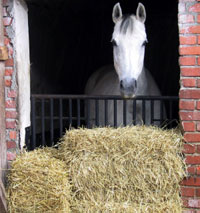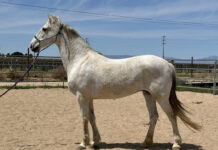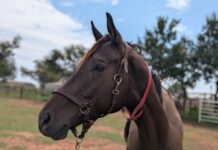The daily exchange of oxygen in our horse’s lungs is something we often take for granted. Flaring nostrils after a brisk gallop is something we equate with good health and that fiery equine mystique that reminds us of our mount’s wild heritage. It’s only when something goes wrong with a cough here or a runny nose there that we realize what can happen when our horse’s respiratory health is at risk. Here is a guide to the most common equine respiratory ailments, how they can be treated, and most importantly, how to prevent them.

Causes
Perhaps the seemingly most ubiquitous respiratory ailment of the adult horse is Recurrent Airway Obstruction (RAO), also known as heaves or “broken wind”, and previously referred to as Chronic Obstructive Pulmonary Disorder (COPD). RAO is a hypersensitivity reaction in the horse’s airways to microscopic allergens in the environment, usually spores of fungi or mold. These allergens cause inflammatory reactions in the horse’s respiratory system, resulting in the release of histamine and other chemical mediators that increase production of airway secretions and cause constriction of the airways. This bronchoconstriction results in the following clinical signs: increased respiratory effort, exercise intolerance, and a chronic cough. Some horses suffering from chronic and untreated heaves develop what is called a “heave line” – excessive muscle development along the rib cage from constant heavy breathing.
Once diagnosed by a veterinarian, heaves can usually be controlled by environmental management (see below) and therapeutic drugs. Medications used usually involve steroids and bronchodilators, sometimes in the form of inhalants.
The most common causes of contagious respiratory diseases are a result of viral infections. Horses are susceptible to the influenza virus, as well as the herpes virus family, specifically equine herpesvirus 4, also known as rhinopneumonitis. Both of these illnesses usually result in a fever, lethargy, and some nasal discharge with or without a cough. Antibiotics are usually given to prevent secondary bacterial infections, and rest, TLC, and other supportive care such as IV fluid therapy, may be required as the horse recovers. Other viruses such as equine herpesvirus 1 and adenovirus can also cause respiratory illness, but are not as common as the other two viruses mentioned here.
Strangles, caused by the bacterium Streptococcus equi, is another highly contagious respiratory disease, manifested by abscessed lymph nodes located most commonly under the horse’s jaw line, or throatlatch, area. Although normally a superficial disease, occasionally the bacteria spread systemically, causing what is called “bastard strangles” which can be life threatening.
The use of antibiotics to treat strangles is sometimes debatable and oftentimes this condition is managed with supportive care until the abscesses are drained. The fluid from these abscesses contains enormous amounts of bacteria, making the contents highly contagious, leaving clean up of the disease to be a nightmare for a large barn. Prevention by vaccine is the best course of action.
Prevention
The air quality in your horse’s daily environment is the greatest influencer on the health of your horse’s lungs. Environmental dust and allergens or the exposure to pathogens spread by other horses can, to a certain extent, be eliminated through proper barn management.

The most natural environment for a horse to live is outside. Many horse owners assume a cozy stall is the ideal environment when in fact a large pasture is the easiest place to decrease dust/mold/pollen and other allergens that can cause inflammatory reactions within your horse’s lungs.
However, in many places a wide-open field is simply not a feasible way to keep a horse. If this is the case, you can still keep the “no-allergen” rule in mind when stalling a horse. Firstly, choose your bedding wisely – not all straws and shavings are created equal. Experiment with different composites and brands to find the bedding that generates the least amount of dust. Secondly, evaluate the hay. Depending on the cutting and the age of the bales, hay can be extremely dusty – if this is the case, simply wetting the hay down does an excellent job of ridding extra dust.
Also consider where your hay is stored. The best place to store hay is in another building altogether. If this is not feasible, moving the hay as far from the stalls as possible is another solution.
Ventilation is also important. Always try to keep as many doors and windows open in the barn as possible, allowing fresh air to travel through and circulate away dust and ammonia fumes.
A current vaccine program is the best prevention against infectious causes of respiratory disease. Your horse’s personal vaccine program will be determined by many factors, so be sure to discuss it with your veterinarian. In general, if your horse has at least some exposure to other horses, vaccines for influenza and rhinopneumonitis are warranted. Horses that travel frequently should be boostered for “flu/rhino” at least twice a year. There are also vaccines available for strangles.
When traveling, bring your horse’s own grooming equipment and buckets. Don’t share tack and keep direct contact between your horse and others to a minimum.
By implementing some simple management practices into your routine along with being aware of the most common respiratory diseases, preventing these problems in your horse can be fairly straightforward, allowing you to breathe easy when it comes to the health of your horse’s lungs.
Further Reading
Heaves in Horses
Why does my senior horse cough?





even though i am learning about horses, i really feel like life is connected in many ways.
The quiz question about strangles is incorrect. It asks you to mark the sentence which is NOT true about strangles. I was confused since I knew all to be true, so I just marked one to see what would happen. It marked my answer as incorrect ( which I knew was the case), but explained that “A” was the correct answer. That answer given was most definitely true- it was about the strangles vaccine- there definitely are both in injectable and intranasal forms and it is mentioned in the article…!
I got question 9 marked wrong:
The question was:
What is statement is not true about Strangles?
The test said the correct answer was A which was
that there is no vaccine for Strangles.
In the required reading in the third to last paragraph it states that there ARE vaccines available for Strangles. Which statement is correct?
Jeff and Rebecca,
Remember that the question is asking you which statement is NOT true about strangles. The statement that says there is no vaccine is not true, and therefore is the correct answer.
If you have any other questions, you can send a comment by using this form: http://www.horsechannel.com/contact-us.aspx
Hi my horse has has heaves for 1 year and I tried several things cough free, wind aid, ventipulin syrup, dex packs, and air power I had to retire him please help me he is 16 but we had him checked by a vet please help me.
I am new to horses and kept reading about “strangles” wondering what the heck that was. Article was very informative and answered my questions. thanks!
Surprised at how much of this I didn’t know!
Thanks for the good information in all your classes!
Great advice.